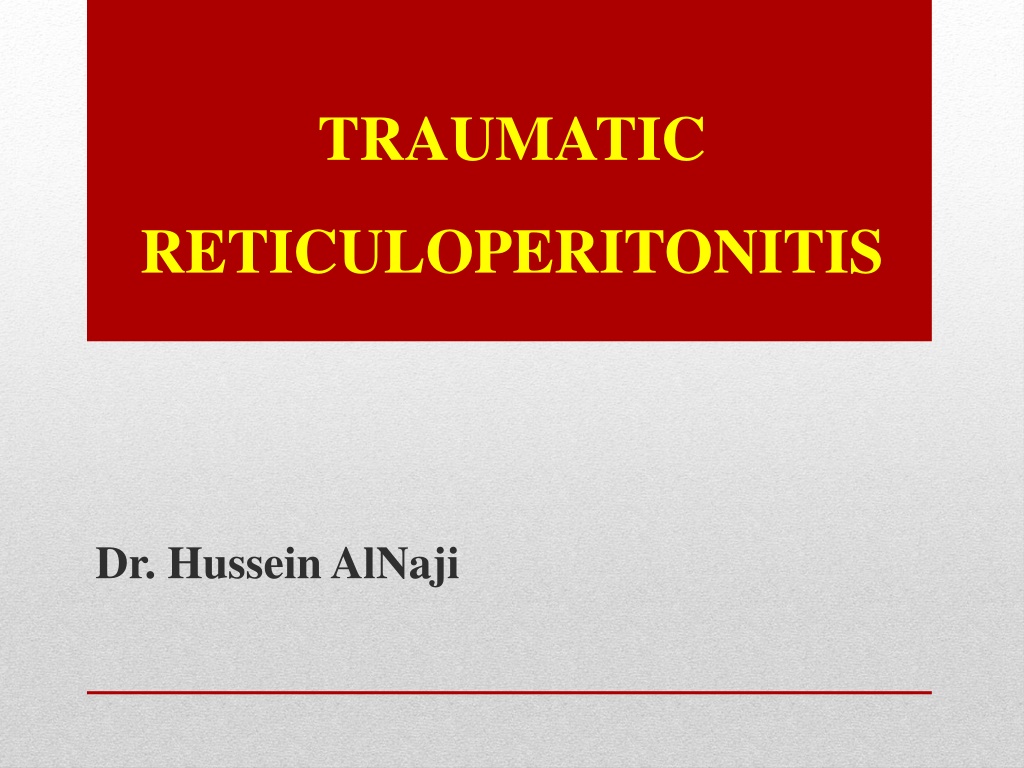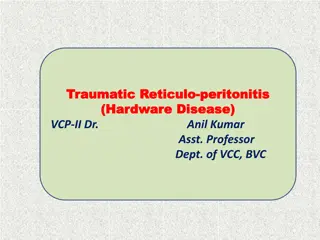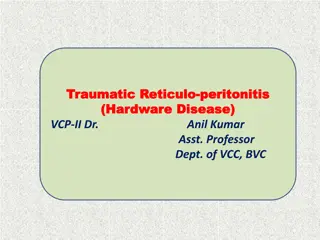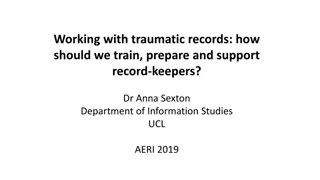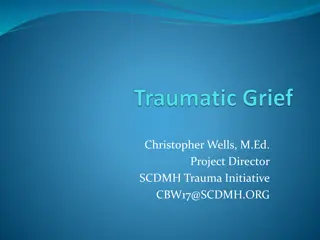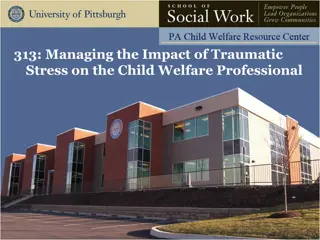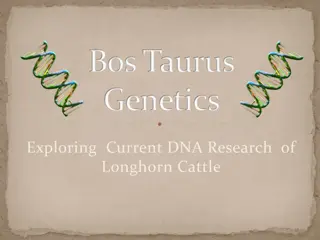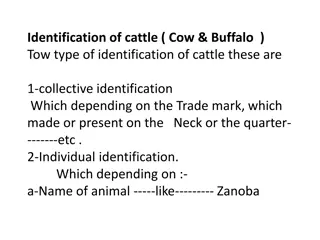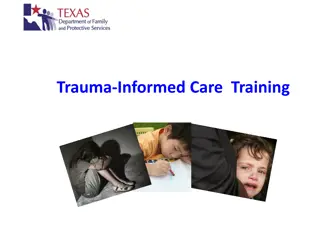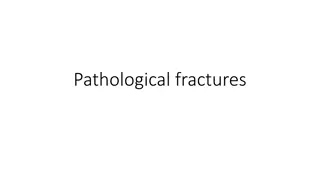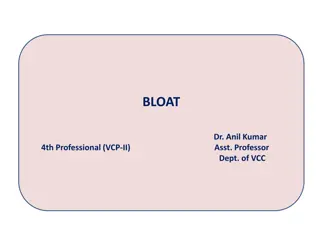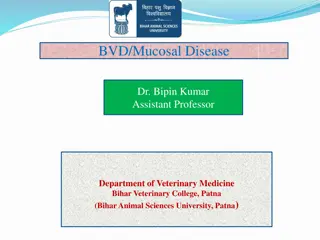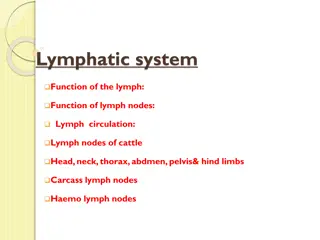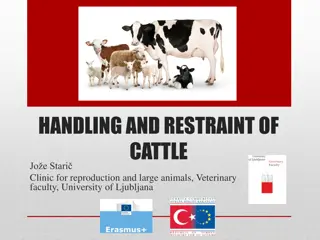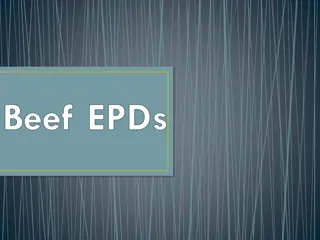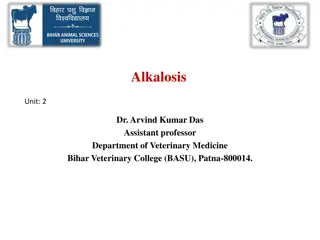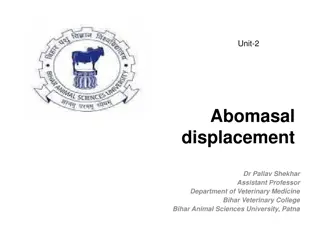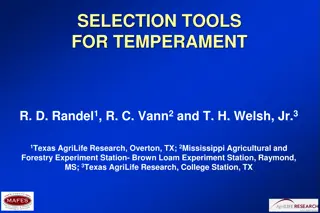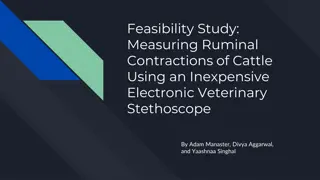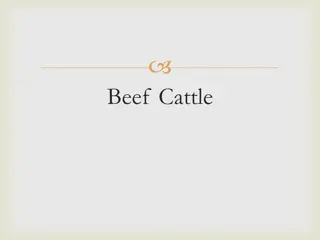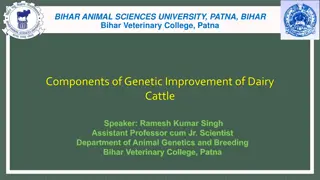Understanding Traumatic Reticuloperitonitis in Cattle
Traumatic reticuloperitonitis in cattle is a severe condition caused by the penetration of the reticulum by metallic foreign objects. The ingestion of these objects leads to acute local peritonitis, with symptoms like anorexia, decreased milk yield, and pain during movement. If left untreated, it can result in serious complications and high mortality rates. Early diagnosis and appropriate treatment are crucial to prevent economic losses and ensure the health of the animals.
Download Presentation

Please find below an Image/Link to download the presentation.
The content on the website is provided AS IS for your information and personal use only. It may not be sold, licensed, or shared on other websites without obtaining consent from the author. Download presentation by click this link. If you encounter any issues during the download, it is possible that the publisher has removed the file from their server.
E N D
Presentation Transcript
TRAUMATIC RETICULOPERITONITIS Dr. Hussein AlNaji
Perforation of the wall of the reticulum by a sharp foreign body initially produces an acute local peritonitis, ETIOLOGY Traumatic reticuloperitonitis is caused by the penetration of the reticulum by metallic foreign objects that have been ingested in prepared feed. Baling or fencing wire that has passed through a chaff cutter, feed chopper, or forage harvester is one of the most common causes. Economic Importance The disease is economically important because of the severe loss of production it causes and the high mortality rate.
Ingestion of Foreign Body Pathogenesis Penetration of Reticulum Perforations laterally in the direction of the spleen and medially toward the liver perforations occur in the lower part of the cranial wall of the reticulum injured without penetration to the serous surface Acute Local Peritonitis
clinical signs commence about 24 h after penetration. Generalized or diffuse peritonitis Complicationsor sequels Less common sequelae 1- laceration or erosion of the left gastroepiploic artery causing sudden death from internal hemorrhage. Common sequels 1- Traumatic pericarditis, 2- vagus indigestion 2- diaphragmatic abscess. 3- diaphragmatic hernia 3-Acute suppurative pleuritis and pneumonia. 4- traumatic abscess of the spleen and liver.
Clinical signs Acute local peritonitis 1. Sudden onset with complete anorexia and a marked drop in milk yield. 2. The animal is reluctant to move and does so slowly . Walking, particularly downhill, is often accompanied by grunting. 3. Most animals prefer to remain standing for long periods and lie down with great care; habitual recumbency is characteristic in others. 4. Arching of the back occurs in about 50% of cases. 5. Defecation and urination cause pain, and the acts are performed infrequently and usually with grunting.
6- A moderate systemic reaction is common in acute localized peritonitis. The temperature ranges from 39.5 C to 40 C. 7- Rumination is absent and reticulorumen movements are markedly depressed and usually absent. 8- Pain can be elicited by deep palpation of the abdominal wall just caudal to the xiphisternum. 9- Pinching the withers to cause depression of the back and eliciting a grunt is also an effective diagnostic aid
Chronic Local Peritonitis In chronic peritonitis the appetite and milk yield do not return to normal after prolonged therapy with antimicrobials. The body condition is usually poor, the feces are reduced in quantity, and there is an increase in undigested particles. Acute Diffuse (Generalized) Peritonitis Acute diffuse peritonitis is characterized by the appearance of profound toxemia within a day or two of the onset of local peritonitis. Alimentary tract motility is reduced
Sudden Death There is a record of sudden death in a 20-month-old pregnant heifer in which the reticular vein was punctured by a migrating piece of metal wire, causing fatal hemorrhage into the reticulum.
CLINICAL PATHOLOGY A.Hemogram: 1. acute local peritonitis neutrophilia (mature neutrophils above 4000 cells/ L) and a left shift (immature neutrophils above 200 cells/ L) are common. This is a regenerative left shift. 2. In acute diffuse peritonitis a leukopenia (total count below 4000 cells/ L) with a greater absolute number of immature neutrophils than mature neutrophils (degenerative left shift) occurs, which suggests an unfavorable prognosis if severe.
A.Increase Plasma Protein, Fibrinogen and Coagulation Profile. B. Abdominocentesis and Laboratory evaluation of peritoneal fluid: consists of determinations of total white blood cell count, differential cell count, total protein, and culture for pathogens. C.RADIOGRAPHY OF CRANIAL ABDOMEN AND RETICULUM. D.Ultrasonography for Traumatic Reticuloperitonitis. E. Metal detectors F. LAPAROSCOPY.
NECROPSY FINDINGS Localized traumatic reticuloperitonitis is characterized by varying degrees of locally extensive fibrinous adhesions between the cranioventral aspects of the reticulum and the ventral abdominal wall and the diaphragm. Adhesions and multiple abscesses may extend to either side of the reticulum involving the spleen, omasum, liver, abomasum, and ventral aspects of the rumen. Large quantities of turbid, foul-smelling peritoneal fluid may be present, containing fibrinous clots.
In acute diffuse peritonitis a fibrinous or suppurative inflammation may affect almost the entire peritoneal cavity with extensive fibrinous adhesions of various stages of development involving the forestomach, abomasum, small and large intestines, liver, bladder, reproductive tract, and pelvic cavity. Large quantities of turbid, foul- smelling fluid containing clots of fibrin are usually present.
Differential Diagnosis Acute local traumatic reticuloperitonitis Acute local traumatic reticuloperitonitis must be differentiated from those diseases in which sudden anorexia, sudden drop in milk production, ruminal atony, abdominal pain, and abnormal feces are common. They include the following:
1. Simple indigestion 2. Obstruction of reticuloomasal orifice. 3. Acute carbohydrate engorgement. 4. Acute intestinal obstruction. 5. Abomasal volvulus (following right side dilatation). 6. Pericarditis. 7. Acute pleuritis. 8. Perforated abomasal ulcer. 9. Postpartum septic metritis. 10.Pyelonephritis. 11.Acute hepatitis or severe hepatic abscess. 12-Acetonemia
TREATMENT Two methods of treatment are in general use: conservative treatment with or without the use of a magnet and rumenotomy: 1. Oral administration of the strongest magnet possible to cattle 2. Procaine penicillin 22,000 U/kg BW IM daily for at least 5 days 3. Oxytetracycline 16.5 mg/kg IV daily for at least 5 days Minimize 4. Movement by keeping confined in a small stall 5. Rumenotomy and wire removal for cattle of higher economic value or after 3 days of medical treatment with no improvement
Control 1. Routine oral administration of the strongest magnet possible to dairy cattle eating chopped feed 2. Ensure feed chopping equipment have magnets attached to remove metal from feed
